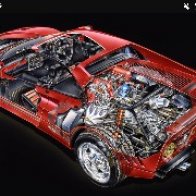-
Welcome to Auto Parts Forum
Whether you are a veteran automotive parts guru or just someone looking for some quick auto parts advice, register today and start a new topic in our forum. Registration is free and you can even sign up with social network platforms such as Facebook, X, and LinkedIn.
Vintage irvin lap belt
-
Similar Topics
-
By NAPA
Chase Elliott and the No. 9 link hidden, please login to view team qualified ninth for Sunday’s NASCAR Cup Series race at Talladega Superspeedway. Elliott led laps en route to a second-place result in stage one and followed that up with an eighth-place finish in stage two. After making multiple moves to try to advance to the front of the field towards the end race, he avoided a last-lap multi-car incident to finish 15th. The 28-year-old driver now sits third in the Cup Series point standings, just 22 markers behind the leader. Chase Elliott advanced to the final round of Saturday’s qualifying session, ultimately claiming a ninth-place starting position for Sunday’s NASCAR Cup series race at Talladega Superspeedway. Early in the race, Elliott opted to drop back in the field in an effort to conserve fuel. He maneuvered his way forward utilizing the outside lane as the field went three wide. Eventually, the driver of the No. 9 NAPA Auto Parts Chevrolet Camaro ZL1 found the front of the pack and took over the lead for the first time of the race on lap 42. Just two laps later, Elliott made his way to pit road for a fuel-only stop. Once green-flag stops cycled through, the 28-year-old driver retook the lead. He raced side-by-side with the No. 2 for the top spot as the field ran double file. Elliott came up just short of the stage win, taking the green-and-white checkered flag in second at the conclusion of lap 60.
Under the stage-ending caution, Elliott relayed that he thought he wore out the right front tire. After the team made a pit stop for four tires and fuel, crew chief Alan Gustafson examined the tires and relayed to Elliott that the right front looked fine. The 2020 Cup Series champion was the second one off of pit road but opted to line up on the outside of row two to start the second stage. The majority of the field went back to three-wide racing and Elliott utilized all the lanes throughout the stage to find momentum. On lap 103, he brought the NAPA Auto Parts Chevrolet to the attention of his crew for fuel. In the closing laps of stage two, Elliott was running among the front half of his competitors and scored an eighth-place result at its lap-120 conclusion.
After pitting for four tires and fuel during the stage break, the team opted to pit again to top off the fuel tank of the NAPA Auto Parts Chevy. Elliott took the green flag for the final stage deep in the field and was running just outside of the top 20 when the yellow flag waved for a multi-car incident. After pitting for fuel only, Elliott restarted inside the top 15 and continued to run among the top 20 in the running order. After another caution came out on lap, the No. 9 NAPA team took the opportunity to pit for the final time for fuel. Elliott was the 16th to choose his lane for the lap-161 restart and opted for the inside. As the laps wound down, Elliott joined a third lane of cars on the outside. After initially making progress, the lane stalled out and he lost his momentum. On the final lap of the race, the leaders triggered a multi-car incident and Elliott avoided the melee to earn a 15th-place finish.
A solid points day for Elliott moved him up to third in the Cup Series driver standings. He’ll head to Dover Motor Speedway next week just 22 markers behind the leader.
Start / Finish: 9 / 15
Points Standing / Total: 3rd / 337 (-22)
Next Race: Sunday, April 28, Dover Motor Speedway
How to Watch or Listen: 2:00 p.m. ET on FS1, PRN or SiriusXM
NAPA:
link hidden, please login to view
Chase Elliott: link hidden, please login to view
Hendrick Motorsports: link hidden, please login to view
No. 9 Team: link hidden, please login to view The post
link hidden, please login to view appeared first on link hidden, please login to view.
link hidden, please login to view -
By Counterman
Litens Aftermarket introduced its new “System Reset” campaign, aiming to bring awareness to the importance of proper drive-belt system maintenance.
In an effort to educate professional vehicle service technicians, Litens details what a system reset entails, its significance and the potential repercussions of neglecting this essential maintenance step when replacing a drive belt.
For a belt-drive system to perform optimally, the system’s components must be properly maintained and in tune with each other throughout the lifespan of the vehicle. When it’s time to replace the drive belt, it’s also time to replace the drive-belt system’s tensioners and pulleys. The system is properly reset when all components of the belt-drive system, including the tensioner, idler pulley(s) and the belt, are all replaced at the same time.
“As vehicle belt-drive systems become more complex, we’re aiming to equip technicians with both education and solutions,” said Scott Howat, national sales manager, Litens Aftermarket. “Properly resetting the belt-drive system enables the technician to reset the vehicle to its optimal OE level of performance.”
Benefits of a system reset – replacing the tensioner and idler pulley(s) along with the belt – include enhancing the system’s reliability and longevity, as well as reducing the risk of component failure and subsequent breakdowns. Resetting all of the belt-drive system components together promotes optimal power transmission, minimizing slippage and improving overall efficiency, which can contribute to enhanced fuel economy and performance.
Failing to fully reset the system can lead to imbalanced stress distribution, reduced overall system efficiency and premature wear of both the newly replaced parts and the remaining older components. This could result in increased friction, potential belt slippage and an elevated risk of component failure, ultimately compromising the entire belt-drive system’s reliability and performance.
Litens designs OE belt-drive systems and components to last for a designated period of time. While that number also depends on miles driven and the number of vehicle starts/stops, the belt-drive system typically runs for 100,000 miles before needing maintenance. As all of the system’s components are designed to work together, when the belt is due for replacement, it’s highly likely that the rest of the components in the system are also due.
For more information, visit
link hidden, please login to view. The post
link hidden, please login to view appeared first on link hidden, please login to view.
link hidden, please login to view -
-
By Counterman
Litens Aftermarket recently introduced its latest OE improvement, the 999420A belt tensioner.
This new tensioner boasts improvements to the OE design, enabling an efficient belt-tensioner replacement process by a single technician, according to Litens.
“This tensioner was engineered to improve upon the OE design by addressing the challenges technicians encounter during the installation of belt tensioners, particularly in the confined spaces of engine compartments,” Litens explained in a news release. “Focusing on ease of installation, Litens integrated a design advancement to simplify the installation process significantly.”
The design upgrade is the lift feature, strategically placed in an offset position between the mounting bolts that secure the tensioner – adding an extra inch under the lip for a technician, providing greater ease of access.
Typically, a tensioner is located at the side of the engine compartment where there’s very little room for working hands to get a wrench on the tensioner to loosen the belt during installation. The configuration in the Litens tensioner facilitates easy access for technicians to position their wrench when loosening the belt, streamlining the installation process even in the tightest engine compartments, according to the company.
Additionally, the lift feature is designed for a 14-millimeter hex wrench consistent with OE design, rather than using a 15-millimeter hex wrench traditionally used on aftermarket tensioners. Consequently, Litens says, the technician has one less tool to keep track of throughout the replacement process.
“As an engineering company that manufactures parts, we recognize the struggles that come with installing these parts in tight space,” said Randy Wolters, product manager, belt-tensioning products, Litens Aftermarket. “With these design improvements we’re able to give the tech an extra set of hands and save them from the bloody knuckles you get when working in such a tight space.”
link hidden, please login to view is available for all Mazda applications between the years 2006 through 2017, covering a total of 30,000 vehicles in operation. The post
link hidden, please login to view appeared first on link hidden, please login to view.
link hidden, please login to view





Recommended Posts
Join the conversation
You can post now and register later. If you have an account, sign in now to post with your account.
Note: Your post will require moderator approval before it will be visible.